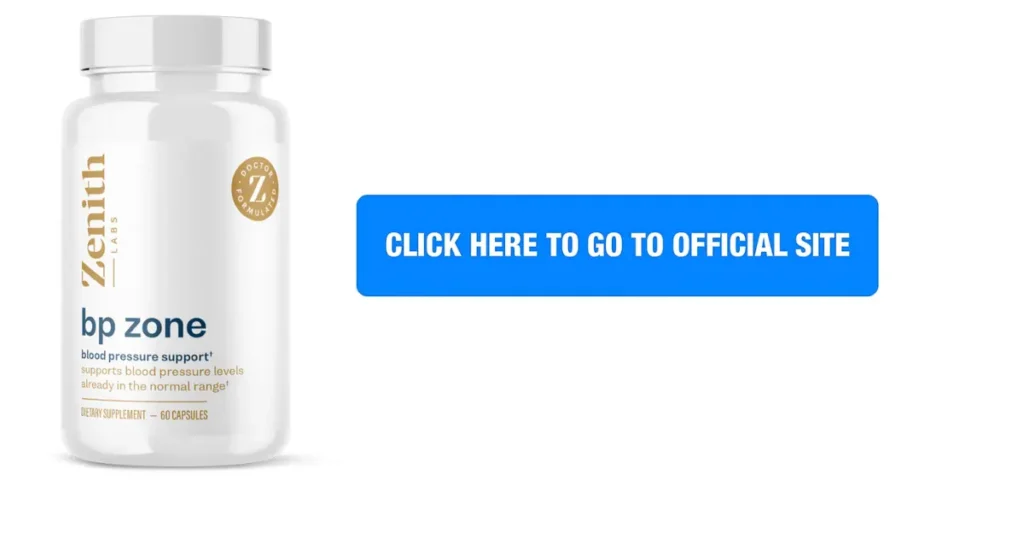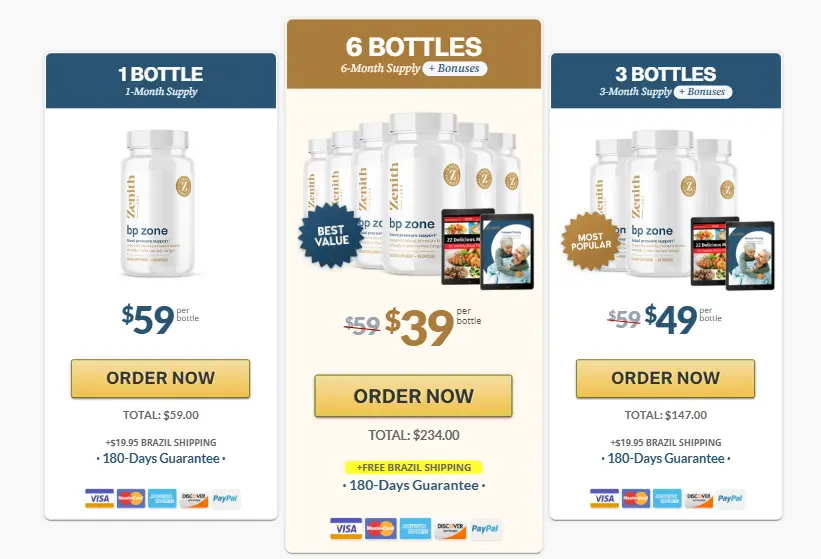
Maintaining healthy blood pressure is a critical component of long-term cardiovascular health. For many people, achieving balance requires a combination of diet, exercise, and sometimes, medication. It’s understandable that many look for natural, complementary solutions.
BP Zone is a dietary supplement positioned to aid those seeking to maintain blood pressure levels already within the normal range. It uses a blend of vitamins, minerals, and herbal extracts clinically studied for their vasodilatory and circulatory benefits.
In this detailed and honest BP Zone Review, we analyze the ingredients, the science, and the claims to determine if this supplement offers effective support for your heart health routine.
READ ALSO:
- Pineal Guardian X Review 2025 – Does It Really Work or Scam?
- ProvaDent Review Still Worth It in 2025?
Follow our PAGE
BP Zone Review: Science and Mechanism of Action
The BP Zone supplement’s core mechanism revolves around two key scientific principles: vasodilation (the widening of blood vessels) and reduction of oxidative stress. By addressing these two areas, the formula aims to promote smoother, less restricted blood flow.
The key ways the supplement claims to support healthy blood pressure include:
- Nitric Oxide (NO) Production: Ingredients often support the synthesis of Nitric Oxide, a molecule essential for relaxing the inner muscles of the blood vessels, leading to vasodilation and reduced pressure.
- Cardiovascular Tone: Certain minerals and extracts help regulate the contraction and relaxation of the heart and blood vessels, promoting a healthy and stable cardiovascular tone.
- Antioxidant Protection: A rich blend of antioxidants helps reduce damage from free radicals in the arteries, supporting the long-term integrity and flexibility of the blood vessel walls.
It is crucial to understand that BP Zone is intended to support levels already within the normal range and not replace prescribed hypertension medication.

Key Ingredients: What is in the BP Zone Formula?
The efficacy of the formula depends on the synergy of its components. BP Zone typically includes ingredients that have significant scientific backing in blood pressure management:
Essential Minerals and Vitamins
- Magnesium: A vital mineral that acts as a natural calcium channel blocker, helping to relax blood vessel muscles and reduce constriction. Studies link adequate magnesium intake to lower blood pressure.
- Potassium: Works to balance the effects of sodium in the body and promotes the relaxation of blood vessels, crucial for maintaining healthy blood pressure levels.
- Vitamin C & B Vitamins: Contribute to antioxidant defense and overall cardiovascular function.
Herbal and Botanical Extracts
- Grape Seed Extract: Contains powerful polyphenols and is often clinically tested (e.g., MegaNatural-BP), known to help improve blood flow and maintain pressure within a healthy range.
- Hawthorn Leaf and Flower Extract: Used traditionally and studied for its ability to promote vasodilation and support healthy heart function.
- Garlic Extract: Widely researched for its benefits in promoting healthy circulation and potentially lowering blood pressure over time.
- Olive Leaf Extract: Contains oleuropein, an antioxidant compound shown in studies to support healthy blood pressure levels.
- L-Theanine & Ashwagandha: Often included for their stress-reducing properties, helping to lower cortisol (the stress hormone) which can be a contributor to high blood pressure.

Pros and Cons of BP Zone
Evaluating the potential benefits against the drawbacks is essential for an informed decision:
✅ Pros
- Science-Backed Ingredients: Contains several nutrients and herbs (Magnesium, Potassium, Grape Seed) with clinical evidence supporting their role in blood pressure regulation.
- Stress Management Component: Includes adaptogens (Ashwagandha and L-Theanine) that address stress, a major contributor to high blood pressure.
- Comprehensive Formula: Targets multiple pathways of cardiovascular health (vasodilation, oxidation, and stress).
- Safe and Natural: Generally well-tolerated and made from natural, non-GMO ingredients in a GMP-certified facility.
❌ Cons
- Not a Cure/Replacement for Medication: The most significant downside is the misconception that it can replace prescription drugs. It cannot and should not be used as such.
- Results Require Time: As with most natural supplements, full, measurable results on blood pressure require consistent use for 3 to 6 months.
- Pill Size: Some users of similar formulas report the capsules can be large and require effort to swallow.
Price and Where to Buy BP Zone
BP Zone is primarily sold online. To get the best price and ensure product authenticity, purchasing from the official website is highly recommended.
Pricing structure (typical for these types of supplements):
- 1 Bottle (30-Day Supply): The starting price (plus shipping).
- 3 Bottles (90-Day Supply): Discounted per bottle.
- 6 Bottles (180-Day Supply): Best value, lowest price per bottle, and often includes free shipping.
Guarantee: A robust 60-day money-back guarantee is usually offered, allowing you to try the product risk-free.

Scam Alert (How To Avoid Scam)
Due to the sensitive nature of blood pressure health, scams surrounding these supplements are common. Protect yourself and ensure you receive the genuine, effective formula by observing the following rules:
1. Official Website Only:BP Zone is only sold on its official website. Avoid Amazon, eBay, Walmart, or unknown third-party retailers. These often sell counterfeit or expired products that may be dangerous or simply ineffective.
2. Watch Out for Unrealistic Claims: Be wary of any advertising promising to “cure” hypertension or eliminate your need for prescribed medication instantly. This supplement is a supportive aid, not a cure.
3. Check the Refund Policy: The 60-day money-back guarantee is only valid for purchases made directly through the official secure sales page. Any purchase outside of this channel voids your guarantee.

Frequently Asked Questions (FAQ)
- Can I stop taking my blood pressure medication if I use BP Zone?Absolutely not. BP Zone is designed to support healthy blood pressure already within the normal range. You must consult your doctor before making any changes to your prescribed medication regimen.
- Are there any side effects? The supplement is generally well-tolerated. Rare side effects may include mild gas or digestive discomfort, which often subside after the first few weeks. If you experience any adverse effects, discontinue use and consult your doctor.
- How do I take the capsules? The recommended use is typically two capsules daily with food. Some brands suggest splitting the dose (one in the morning and one in the evening) for sustained support. Always follow the specific directions on the product label.
Final Verdict: Is BP Zone a Smart Choice?
BP Zone provides a well-rounded formula that utilizes proven natural ingredients to support the mechanisms of healthy blood pressure, circulation, and stress management. It is a viable complementary tool for individuals actively managing their heart health through diet and exercise.
However, its value relies entirely on consistency and the understanding that it is a supplement, not a cure.
Our recommendation: If your doctor approves, this supplement, particularly the 3-to-6-month package, is worth considering to provide natural support for your cardiovascular system.
Click here to visit the official website and secure the best package for BP Zone today!

Hello! My name is Alan Teixeira and I am passionate about helping people live healthier, more balanced lives. From mindful eating to daily habits that promote physical and mental well-being, I believe that small, consistent changes can lead to powerful transformations.
I created this blog to share practical tips, reliable information, and thoughtful insights that can inspire you to take better care of yourself—with balance, mindfulness, and positivity.
If you are looking to improve your health, nourish your body, and build a lighter, more fulfilling routine, you are in the right place. Welcome!





